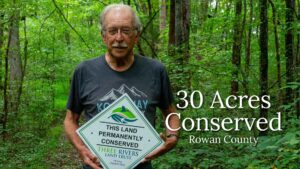
Last week, I was fortunate to get to attend a Natural Heritage Program Rare Plant and Natural Communities Workshop in Hendersonville, North Carolina. This workshop was put on by the North Carolina Association of Environmental Professionals in partnership with NC NHP. The purpose of this workshop was to help participants learn how to identify natural communities and rare plants in the field.
A natural community is defined as “a distinct and reoccurring assemblage of populations of plants, animals, bacteria, and fungi naturally associated with each other and their physical environment” (taken from the Classification of Natural Communities of North Carolina Third Approximation by Mike Schafale, 1990). Mike Schafale is an expert in describing and identifying natural communities and was one of our leaders for this trip.
The first natural community we stopped to see was a Swamp Forest Bog Complex in DuPont State Recreational Forest. Here we saw Swamp Pink, a federally protected plant, although it was past bloom, we still were able to see the spent bloom and the vegetation. We also found climbing fern and pink lady slipper at this site. Bogs are fed by ground water seeps and therefore differ from many other wetland communities.
The second place we stopped was also in DuPont State Forest and it was a Rocky Bar and Shore community. This is an area where the river floods periodically to disturb the environment such that no big trees are found here. One form of this community is the twisted sedge variety, of which we saw some here. We also saw mountain hydrangea, species radiata, which is uncommon in our state, along the shore.
We then went to Triple Falls, a beautiful large waterfall, to see an example of a Spray Cliff Community. Here we found a variety of unique plants that are adapted to this community. One of these was a species known as Brook saxifrage or Allegheny brookfoam. It is at high risk as a result of sedimentation and other pollutants. Mike pointed out that because these spray cliff communities have flowing water year round, the water keeps the temperature steady, they don’t freeze in the winter or get too hot in the summer, and as a result some species of tropical mosses and ferns can be found there. Mike also said that not every waterfall has a good Spray Cliff community.
The next place we visited was Kanuga bog, an example of a French Broad Valley Bog. This bog is owned by Kanuga, a nonprofit conference, retreat and camp center. Kanuga has joined in partnership with Carolina Mountain Land Conservancy to safeguard this environmentally sensitive area for future generations. This partnership has allowed for the restoration and protection of the Kanuga bog under the “Partners for Fish and Wildlife” program from the U.S. Fish and Wildlife Service (USFWS). This site is open to the public. This is a place where mountain sweet pitcher plant, another federally protected plant, grows. These bogs have a number of species that are more often found in the coastal plain. We spotted poison sumac, which is classically found in the Sandhills. So these bogs have an interesting biogeography.
Mike also pointed out that many of the rare species in these bogs are in danger of being shaded in by surrounding vegetation. Given that many of these species are 10,000 plus years old, many people posit why these bogs are growing in and vegetation overshadowing them in the last 20 years? One theory is that there is a lack of disturbance now. Mike doesn’t go for that theory because one of the ways there would be disturbance would be a beaver pond, and when those drain they don’t typically create these bog habitats. Another theory is that these rare species aren’t competing as well anymore. There are lots of stressors, including acid rain and invasive species, that threaten the species now that would not have a few years ago. Also flash flooding from nearby streams brings in additional nutrients that allow other species to grow in these usually harsh environments.
The next three sites we visited were Ochlawaha Bog, East Flat Rock Bog, and Bat Fork Bog. All of these sites are home to a federally protected plant known as bunched arrowhead. The Ochlawaha Bog and the Bat Fork Bog are owned by the state Plant Conservation Program. Plant Conservation Preserves and are not open to the public except through work days organized by the Friends of Plant Conservation (ncplantfriends.org). East Flat Rock Bog is owned by Conserving Carolina, a mountain land trust. Bat Fork Bog is home to a variety of other neat plants, including bog jack-in-the-pulpit, bog manna grass, and littleleaf meadow-rue. Unfortunately, this bog also has an invasive species, reed canary grass, that is prevalent in the field adjacent the bog. PCP leads ongoing efforts to rid the area of this invasive plant.
Needless to say, this was a very enjoyable and informative workshop and I’m glad I attended it. Hopefully they will take my suggestion on the evaluation form and host a similar workshop in the Uwharries in coming years. There are many unique and diverse natural communities and rare species right here in our own backyards.